User:Cease/Corruption
Corruption is a Shadow strategy of corrupting the Ring-bearer, usually by adding burdens until the Ring-bearer's resistance drops to 0. Several cultures can add burdens, but only a few are regularly used in corruption strategies: Ringwraith,
Raider (specifically Easterlings),
Moria (using Lost to the Goblins (1R189)
 ),
), Sauron and
Orc.
Almost every burden-placing Shadow card comes with a choice: "Place a burden or do [x]." Outside of the rare bomb combo deck, corruption decks generally confront the Free Peoples player with a choice, to either accept the burden or accept the other cost, despite the fact that the other cost may result in other setbacks. Because the One Ring can always be used to convert wounds to burdens, undirected wounding (such as Archery or the wounds caused by threats after you kill a character) can also be thought of as a burden effect: your opponent has to either eat the wounds as burdens, or eat them as actual wounds. If you want to be successful with a corruption deck, don't think strictly in terms of how many burdens you can stack, but rather how you can use burdens to create pressure. Each burden-placing Shadow culture creates pressure in different ways.
While corruption or forcing your opponent to make bad choices are the main benefits of burdens, they're not the only benefit. A number of Shadow cards spot burdens to generate some benefit. Many of these cards are very strong in their own right: Úlairë Enquëa, Lieutenant of Morgul (1U231)
 ("Shotgun Enquea") can shoot an opposing companion right off the table if you can spot enough burdens, possible triggering a cascade of threat wounds. The big man himself, Sauron, The Lord of the Rings (9R+48)
("Shotgun Enquea") can shoot an opposing companion right off the table if you can spot enough burdens, possible triggering a cascade of threat wounds. The big man himself, Sauron, The Lord of the Rings (9R+48)
 , gets a Twilight discount from spotting burdens. Several cultures specialize in spotting burdens like this, especially
, gets a Twilight discount from spotting burdens. Several cultures specialize in spotting burdens like this, especially Ringwraiths and Easterling
Raiders. Similarly, some post-Shadows cards harm companions with reduced resistance, particularly Neekerbreekers’ Bog (11S249)
 and Horribly Strong (11R43)
and Horribly Strong (11R43)
 .
.
There are a small handful of cards that lower all companions' resistance, allowing you to score a surprise corruption kill in your own Shadow Phase. The most useful and culture-agnostic of these is Throne of the Dark Lord (17R105)
 .
.
Ultimately, you may find that you're not going to manage to corrupt the ring-bearer. That's not the end of the world. Cards that spot burdens still work, and a number of the cultures that place burdens can also consume them for benefits. Gollum, Dark as Darkness (9R+28)
 and Morgul Brute (7R188)
and Morgul Brute (7R188)
 , in particular, fit into many corruption decks as alternate or supplementary ways to make use of burdens. Consuming the burdens is obviously anti-synergistic with a corruption strategy or cards that spot burdens, but it does allow your deck some more flexibility.
, in particular, fit into many corruption decks as alternate or supplementary ways to make use of burdens. Consuming the burdens is obviously anti-synergistic with a corruption strategy or cards that spot burdens, but it does allow your deck some more flexibility.
sites[edit]
fellowship:
- 1 - Prancing Pony

- 4 - Eregion Hills (3U116)

tower:
king
- 4 - Pelennor Prairie (10U118)

- 5 - Steward's Tomb (10U119)

- 7 - Pelennor Flat (7U345)

- 8 - Northern Ithilien (7U359)

- 9 - Slag Mounds (7U363)
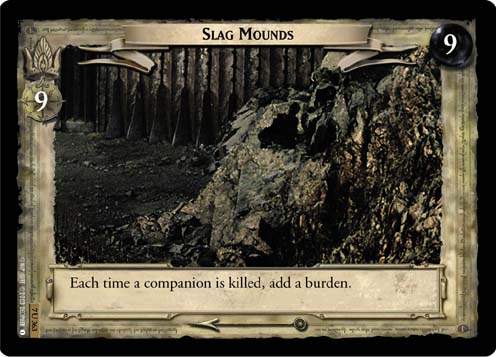
shadows
- 0 - Courtyard Parapet (13U188)
 also weaker alts: Pelennor Flat (11S254)
also weaker alts: Pelennor Flat (11S254)
 (1)
(1) - 1 - Neekerbreekers’ Bog (11S249)

- 1 - Slag Mounds (11S258)
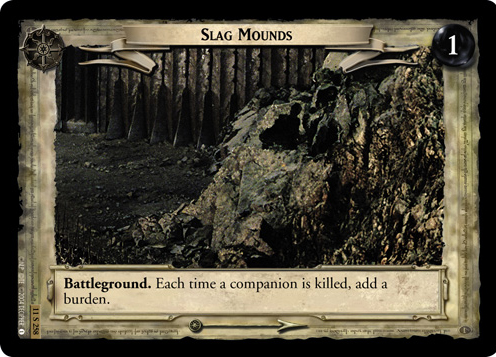
- 1 - Steward's Tomb (18U139)

- 3 - Caves of Aglarond (13S186)
 , also weaker Abandoned Mine Shaft (13U185)
, also weaker Abandoned Mine Shaft (13U185)
 . underground but game text is v limited
. underground but game text is v limited
Sauron culture[edit]
Sauron culture had the first viable corruption strategy. It remains one of the best corruption cultures in Fellowship Block, and many of the same corruption strategies remain relevant later formats. Using cards like Desperate Defense of the Ring (1R244)
 and Thin and Stretched (1R279)
and Thin and Stretched (1R279)
 ,
, Sauron adds burdens slowly to wear down a Ring-bearer's resistance. Even if you aren't close to securing a corruption win, Enduring Evil (1R246)
 is a very strong pump when enough burdens are stacked.
is a very strong pump when enough burdens are stacked.
From early on, Sauron corruption had fairly strong synergy with Sauron Discard: not only does Desperate Defense of the Ring allow discards in lieu of burdens, but The Irresistible Shadow (1R252)
 is a way to turn mill and discard, combined with some corruption, into a victory condition. (The similar Despair (1R243)
is a way to turn mill and discard, combined with some corruption, into a victory condition. (The similar Despair (1R243)
 is largely useless.) Irresistible Shadow does have some downsides, however: firstly, if your opponent's deck is depleted, you've probably defanged their Shadow side, so your Free Peoples can just run down the site path unimpeded. Secondly, while Frodo can have 10 or more base resistance, alternate ring-bearers are usually almost corrupted at 5 burdens. This last obviously isn't a factor until Movie Block when alternate ring-bearers are introduced, however.
is largely useless.) Irresistible Shadow does have some downsides, however: firstly, if your opponent's deck is depleted, you've probably defanged their Shadow side, so your Free Peoples can just run down the site path unimpeded. Secondly, while Frodo can have 10 or more base resistance, alternate ring-bearers are usually almost corrupted at 5 burdens. This last obviously isn't a factor until Movie Block when alternate ring-bearers are introduced, however.
In later sets, Grishnákh, Orc Captain (5R100)
 is a solid, efficient minion, although it's rare that your opponent will eat the burdens. Wisp of Pale Sheen (6C108)
is a solid, efficient minion, although it's rare that your opponent will eat the burdens. Wisp of Pale Sheen (6C108)
 is a weak minion that can add a burden if it survives a skirmish phase. Sauron, The Lord of the Rings (9R+48)
is a weak minion that can add a burden if it survives a skirmish phase. Sauron, The Lord of the Rings (9R+48)
 doesn't apply burdens himself, but does give you an alternate way of keeping up the pressure if you've piled them up.
doesn't apply burdens himself, but does give you an alternate way of keeping up the pressure if you've piled them up.
Orc Officer (7U302)
 can stack on burdens, if you can set up overwhelms. To trigger it, you can use Enduring Evil (1R246)
can stack on burdens, if you can set up overwhelms. To trigger it, you can use Enduring Evil (1R246)
 , high-strength orcs like Orc Slaughterer (10R95)
, high-strength orcs like Orc Slaughterer (10R95)
 , or combos that set up unexpectedly high-strength orcs, like Mordor Guard (7C287)
, or combos that set up unexpectedly high-strength orcs, like Mordor Guard (7C287)
 / Mordor Veteran (7U292)
/ Mordor Veteran (7U292)
 / Fires Raged Unchecked (7R269)
/ Fires Raged Unchecked (7R269)
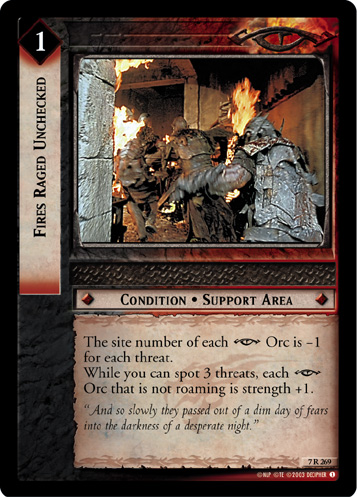 in Sauron Threats, or Advance Scout (10U78)
in Sauron Threats, or Advance Scout (10U78)
 / Advance Marauder (10C76)
/ Advance Marauder (10C76)
 / Flames Within (10C85)
/ Flames Within (10C85)
 in Sauron Roaming. Even if you can't overwhelm a key character, the mere presence of Orc Officer makes chump blocking with a weak or exhausted companion unattractive.
in Sauron Roaming. Even if you can't overwhelm a key character, the mere presence of Orc Officer makes chump blocking with a weak or exhausted companion unattractive.
initiative orcs: Gorgoroth Stormer (8C101)
 Mordor Fighter (7R286)
Mordor Fighter (7R286)
 Orc Stalker (7U307)
Orc Stalker (7U307)
 Besieging Pike (7C265)
Besieging Pike (7C265)
 . get init from fighter, Some Secret Art of Flame (7C313)
. get init from fighter, Some Secret Art of Flame (7C313)
 Tower of Barad-dûr (3R104)
Tower of Barad-dûr (3R104)
 Gothmog's Warg (10R89)
Gothmog's Warg (10R89)

When you do apply a burden, The Ring is Mine! (10U97)
 can add on even more. It's never a bad play to just use this opportunistically to score a burden here and there, but it's especially satisfying when your opponent takes a calculated risk to go down to low resistance, then gets blown away when it turns out you've got three copies of TRIM in your hand.
can add on even more. It's never a bad play to just use this opportunistically to score a burden here and there, but it's especially satisfying when your opponent takes a calculated risk to go down to low resistance, then gets blown away when it turns out you've got three copies of TRIM in your hand.
Ringwraith culture[edit]
While the earliest Ringwraith corruption cards were, charitably, a big old mess, Nazgul have always been good at maximizing the damage once you pile on some burdens. Úlairë Enquëa, Lieutenant of Morgul (1U231)
 and Úlairë Toldëa, Messenger of Morgul (1R236)
and Úlairë Toldëa, Messenger of Morgul (1R236)
 can pick off companions if the burdens stack up, Gates of the Dead City (3R81)
can pick off companions if the burdens stack up, Gates of the Dead City (3R81)
 can grind down the Fellowship to open up a regular win through murder, Úlairë Nelya, Ringwraith in Twilight (2R84)
can grind down the Fellowship to open up a regular win through murder, Úlairë Nelya, Ringwraith in Twilight (2R84)
 is cheap and cheerful if you've got enough pressure on the Ring-bearer, Blade Tip (1U209)
is cheap and cheerful if you've got enough pressure on the Ring-bearer, Blade Tip (1U209)
 and Black Breath (1U207)
and Black Breath (1U207)
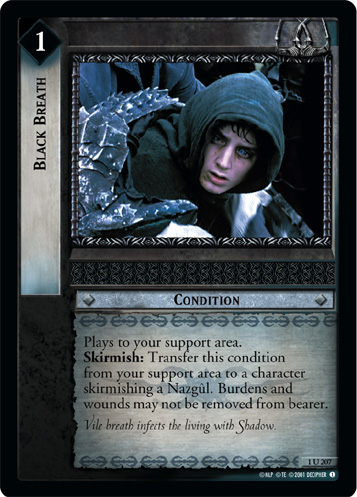 can compound pressure and prevent some types of healing, and Return to Its Master (1R224)
can compound pressure and prevent some types of healing, and Return to Its Master (1R224)
 can score a surprise win if the Ring-bearer is in dire straits. The challenge, especially early on in the game, was applying the burdens in the first place.
can score a surprise win if the Ring-bearer is in dire straits. The challenge, especially early on in the game, was applying the burdens in the first place.
In Fellowship Block, this was difficult. Drawn to Its Power (1U211)
 generally won't apply many burdens over the course of a game unless you're winning anyway, and It Wants to be Found (2U78)
generally won't apply many burdens over the course of a game unless you're winning anyway, and It Wants to be Found (2U78)
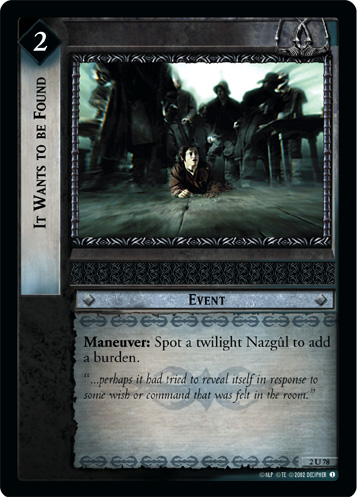 has a strong effect but requires using Twilight Nazgûl, which are mostly lousy. Twilight Nazgûl have lots of tempting-looking tools to stack burdens, like Resistance Becomes Unbearable (2U79)
has a strong effect but requires using Twilight Nazgûl, which are mostly lousy. Twilight Nazgûl have lots of tempting-looking tools to stack burdens, like Resistance Becomes Unbearable (2U79)
 , Wraith-world (2R86)
, Wraith-world (2R86)
 , and The Twilight World (1R228)
, and The Twilight World (1R228)
 , but they tend to clog up your hand as you wait for a perfect setup that never happens. The Twilight Nazgûl minions themselves are generally too expensive and too bad at actually winning skirmishes to ever really get going. A couple strong skirmishers (often armed with Flaming Brand (2R32)
, but they tend to clog up your hand as you wait for a perfect setup that never happens. The Twilight Nazgûl minions themselves are generally too expensive and too bad at actually winning skirmishes to ever really get going. A couple strong skirmishers (often armed with Flaming Brand (2R32)
 ) could them off nearly indefinitely, and strong splashable Free Peoples burden removal (particularly Sam, Son of Hamfast (1C311)
) could them off nearly indefinitely, and strong splashable Free Peoples burden removal (particularly Sam, Son of Hamfast (1C311)
 ) could deal with the overflow.
) could deal with the overflow.
Ringwraith corruption slowly improved in later sets. Two Nazgûl in particular, Úlairë Attëa, Wraith on Wings (7R210)
 and Úlairë Toldëa, Winged Sentry (6R88)
and Úlairë Toldëa, Winged Sentry (6R88)
 fit snugly into traditional Nazgul Beatdown. Attea's game text was a little unreliable unless you're using Streaming to the Field (8U78)
fit snugly into traditional Nazgul Beatdown. Attea's game text was a little unreliable unless you're using Streaming to the Field (8U78)
 , but unlike the Twilight Nazgûl, you aren't paying too much for a minion that wasn't particularly fearsome in a skirmish.
, but unlike the Twilight Nazgûl, you aren't paying too much for a minion that wasn't particularly fearsome in a skirmish.
Wraith corruption decks finally fully came together in Movie Block, first with Morgul Orcs. Morgul Brute (7R188)
 (often in conjunction with Morgul Destroyer (7U190)
(often in conjunction with Morgul Destroyer (7U190)
 ) forces the ring-bearer to eat a wound or a burden, and the latter is an attractive prospect when faced with the threat of minions like Morgul Whelp (7U202)
) forces the ring-bearer to eat a wound or a burden, and the latter is an attractive prospect when faced with the threat of minions like Morgul Whelp (7U202)
 or Morgul Hound (7C192)
or Morgul Hound (7C192)
 . While feeding the burdens to the Brute obviously won't get you any closer to corrupting the ring-bearer, the mere threat of doing so makes it difficult for your opponent to make optimal assignments, and gives you the option to close out the game with violence instead of corruption. The Morgul Orcs deck is also a swarm deck, and alternate ring-bearers (like Isildur, Bearer of Heirlooms (9R+33)
. While feeding the burdens to the Brute obviously won't get you any closer to corrupting the ring-bearer, the mere threat of doing so makes it difficult for your opponent to make optimal assignments, and gives you the option to close out the game with violence instead of corruption. The Morgul Orcs deck is also a swarm deck, and alternate ring-bearers (like Isildur, Bearer of Heirlooms (9R+33)
 ) will corrupt themselves if you keep forcing them into skirmishes.
) will corrupt themselves if you keep forcing them into skirmishes.
Those alternate ring-bearers were another boon to Wraith culture. While Bill Ferny, Swarthy Sneering Fellow (2R75)
 was nothing new, but previously he was little threat to the ring-bearer as soon as Frodo had a hand weapon. However, many of the most popular alternate ring-bearers stack burdens or wounds on themselves every time they get into a skirmish, so now Bill showing up to frown at them actually does some significant damage. Much later, in Expanded, Úlairë Nertëa, Dark Horseman (19P38)
was nothing new, but previously he was little threat to the ring-bearer as soon as Frodo had a hand weapon. However, many of the most popular alternate ring-bearers stack burdens or wounds on themselves every time they get into a skirmish, so now Bill showing up to frown at them actually does some significant damage. Much later, in Expanded, Úlairë Nertëa, Dark Horseman (19P38)
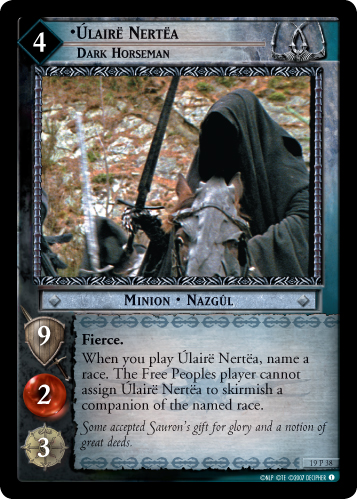 can often do the same, although most multicultural Free Peoples decks, even with just a splash of another culture, can keep him from simply homing in on the ring-bearer.
can often do the same, although most multicultural Free Peoples decks, even with just a splash of another culture, can keep him from simply homing in on the ring-bearer.
Nazgûl got their day in the, uh, shadows as well. Úlairë Enquëa, Thrall of the One (10R68)
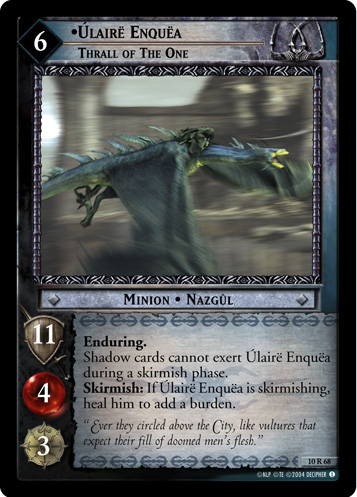 , can stack as many as three burdens every time he comes out, as long as you get some wounds on him. Your opponent's archers can help with that, but mainly you'll want cards that exert him, such as Bent on Discovery (1R206)
, can stack as many as three burdens every time he comes out, as long as you get some wounds on him. Your opponent's archers can help with that, but mainly you'll want cards that exert him, such as Bent on Discovery (1R206)
 , The Ring Draws Them (3U83)
, The Ring Draws Them (3U83)
 , Between Nazgûl and Prey (8R67)
, Between Nazgûl and Prey (8R67)
 , and Ithil Stone (9R+47)
, and Ithil Stone (9R+47)
 . This block also introduced many ways to recur a key Nazgûl, like Out of Sight and Shot (7R204)
. This block also introduced many ways to recur a key Nazgûl, like Out of Sight and Shot (7R204)
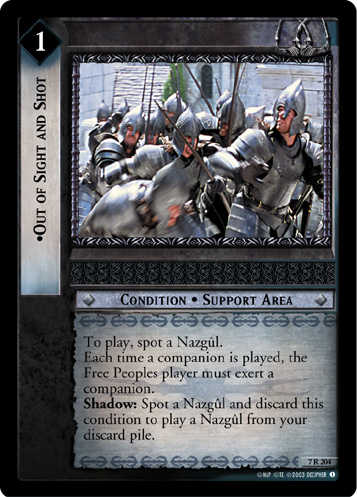 , Flung Into the Fray (8U71)
, Flung Into the Fray (8U71)
 , Morgul Squealer (8R77)
, Morgul Squealer (8R77)
 , Ring of Asperity (9R42)
, Ring of Asperity (9R42)
 , Ring of Rancor (9R44)
, Ring of Rancor (9R44)
 , and The Witch-king, Morgul King (7R221)
, and The Witch-king, Morgul King (7R221)
 . If you're running a whole deck of Enduring Nazgûl, Dark Swooping Shadows (10R58)
. If you're running a whole deck of Enduring Nazgûl, Dark Swooping Shadows (10R58)
 is a one-shot option to turn their wounds into more burdens. This deck stays competitive in Expanded, and even picks up some new tools like Keening Wail (11R211)
is a one-shot option to turn their wounds into more burdens. This deck stays competitive in Expanded, and even picks up some new tools like Keening Wail (11R211)
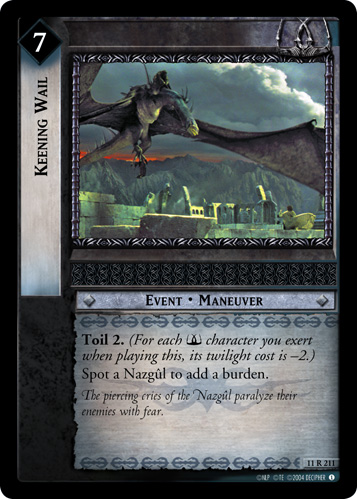 and The Witch-king, Captain of the Nine Riders (11R226)
and The Witch-king, Captain of the Nine Riders (11R226)
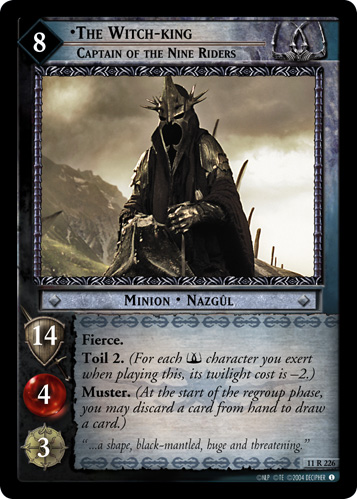 .
.
Their power / relentless charge / beauty ???
black marshal
Expanded added a bunch of different strong corruption tools, which can be used on their own or in conjunction with Enquea TOTO decks. Woody-End (11S266)
 eats a burden, but it's both an alternate win condition and burden-positive
eats a burden, but it's both an alternate win condition and burden-positive
expanded:
- Úlairë Attëa, Second of the Nine Riders (11R219)
 exerts to burden once some are stacked
exerts to burden once some are stacked - Úlairë Nelya, Third of the Nine Riders (11S222)
 for site abuse
for site abuse - Úlairë Toldëa, Black Shadow (12U180)
 to recycle events
to recycle events - Úlairë Otsëa, Duplicitous Specter (17R141)
 ???
??? - Woody-end eats a burden, but worth for enquea toto
- gates of the dead city + dark fell about him + lingering shadow (+ dark temptation) + duplicitous lieutenant
- trap is sprung
- sense of obligation
- The Witch-king, Black Lord lol exerts, prob too bad to mention
- Shapes Slowly Advancing is technically corruption but a different thing (and Morannon Plains btw), and also Put Forth His Strength (not exp) sucks
raiders[edit]
Easterling corruption often instead goes for a beatdown strategy with Small Hope (7R159)
 , Easterling Captain (4R225)
, Easterling Captain (4R225)
 , Easterling Polearm (6U79)
, Easterling Polearm (6U79)
 , and Raider Bow (7C155)
, and Raider Bow (7C155)
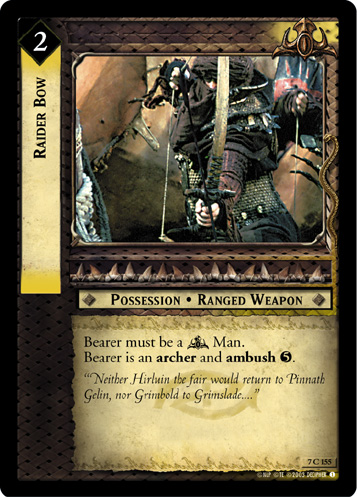 . However, with cards like Easterling Lieutenant (4C228)
. However, with cards like Easterling Lieutenant (4C228)
 , Easterling Guard (4C226)
, Easterling Guard (4C226)
 , and Vision From Afar (4R259)
, and Vision From Afar (4R259)
 , corrupting the Ring-bearer is also possible.
, corrupting the Ring-bearer is also possible.
Moria corruption is the rarest of these, with only the occasional Lost to the Goblins (1R189)
 bomb deck. This archetype is rare, but piling up 12 burdens in one Shadow Phase can be quite an unpleasant shock for your opponent!
bomb deck. This archetype is rare, but piling up 12 burdens in one Shadow Phase can be quite an unpleasant shock for your opponent!
orc[edit]
Retribution (12R101)
 (usually with Orc Spear (12C96)
(usually with Orc Spear (12C96)
 or Mordor Scimitar (11C128)
or Mordor Scimitar (11C128)
 ), Porter Troll (11R135)
), Porter Troll (11R135)
 , Mocking Goblin (11C127)
, Mocking Goblin (11C127)

Orc corruption is potentially the strangest corruption strategy, recyling Isengard Underling (11C125)
 with Goblin Hordes (11R123)
with Goblin Hordes (11R123)
 , which recurs Bound to its Fate (11U110)
, which recurs Bound to its Fate (11U110)
 , and also playing Orc Miscreant (11C131)
, and also playing Orc Miscreant (11C131)
 with Relentless Warg (17R89)
with Relentless Warg (17R89)
 for extra burdening power.
for extra burdening power.
BTTF in hand, isengard to recur, recurred BTTF, then porter last where possible
gollum[edit]
Heavy Burden (7U60)
 , Not Yet Vanquished (11R48)
, Not Yet Vanquished (11R48)
 , Nasty, Foul Hobbitses (6C42)
, Nasty, Foul Hobbitses (6C42)
 , Trap Is Sprung (13R57)
, Trap Is Sprung (13R57)

Gollum, Mad Thing (10R21)
 and Reclaim the Precious (10U22)
and Reclaim the Precious (10U22)

Gollum, Dark as Darkness (9R+28)

threat strategies in general
Notable cards in other cultures[edit]
Saruman, Master of the White Hand (17R116)
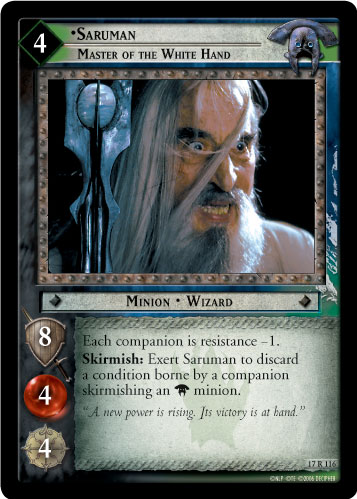
Orthanc Berserker (3R66)
 ? Traitor's Voice (1U142)
? Traitor's Voice (1U142)
 ? Worry (1U162)
? Worry (1U162)
 ?
?
Resistance and Alternate Ring-bearers[edit]
Frodo himself is one of the best defenses against corruption, as the ring-bearer with the highest resistance (in most cases). He has 10 resistance, and 12 if you're using Frodo, Resolute Hobbit (10P121)
 . Other ring-bearers—only seen in King Block/Movie Block and later— will generally have less. Bilbo, Bearer of Things Burgled (9R+49)
. Other ring-bearers—only seen in King Block/Movie Block and later— will generally have less. Bilbo, Bearer of Things Burgled (9R+49)
 has 8, and Galadriel, Bearer of Wisdom (9R+14)
has 8, and Galadriel, Bearer of Wisdom (9R+14)
 and Sam, Bearer of Great Need (13R156)
and Sam, Bearer of Great Need (13R156)
 will generally have between 8 and 9 if no companions have been killed. The other popular ring-bearers will generally have 5-7 resistance under normal circumstances, but they all have a nasty condition where they generate either burdens or some other downside (generally threats or wounds) if they ever skirmish. So forcing them to skirmish over and over, either with swarms or evasive minions like Bill Ferny, Swarthy Sneering Fellow (2R75)
will generally have between 8 and 9 if no companions have been killed. The other popular ring-bearers will generally have 5-7 resistance under normal circumstances, but they all have a nasty condition where they generate either burdens or some other downside (generally threats or wounds) if they ever skirmish. So forcing them to skirmish over and over, either with swarms or evasive minions like Bill Ferny, Swarthy Sneering Fellow (2R75)
 or Úlairë Nertëa, Dark Horseman (19P38)
or Úlairë Nertëa, Dark Horseman (19P38)
 , can lead to them helping to corrupt themselves.
, can lead to them helping to corrupt themselves.
Elendil, High-king of Gondor (13R65)
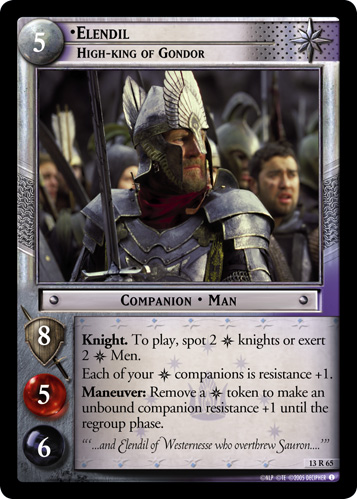
Free Peoples counterplay[edit]
As strong as these strategies may seem, the Free Peoples player has some counterplay. Shire and
Gandalf cultures in particular specialize in burden removal.
The biggest problem in Shire culture is Sam. The most notorious version of him, albeit one banned in Expanded, is Sam, Son of Hamfast (1C311)
 , with his ability to remove up to 3 burdens immediately after being played. Then, he can linger in play and turn any excess healing into more burden removal, or just die to the largest minion. Even when it's not Son of Hamfast, most versions of Sam can take over as ring-bearer if Frodo dies. While Sam's resistance is much lower, all of the existing burdens get wiped when Frodo dies. Helpless (2U76)
, with his ability to remove up to 3 burdens immediately after being played. Then, he can linger in play and turn any excess healing into more burden removal, or just die to the largest minion. Even when it's not Son of Hamfast, most versions of Sam can take over as ring-bearer if Frodo dies. While Sam's resistance is much lower, all of the existing burdens get wiped when Frodo dies. Helpless (2U76)
 can help
can help Wraith decks be a little less vulnerable to Sam shenanigans, but it can't stop Son of Hamfast from coming down and wiping three burdens immediately.
Sam isn't the only strong Shire burden removal tool. Hobbits have many one-shot cards that remove burdens, too many to list. There are also a few standout reusable tools that remove burdens, like A Light in His Mind (10U108)
 , Bilbo, Aged Ring-bearer (13R142)
, Bilbo, Aged Ring-bearer (13R142)
 , Sting, Weapon of Heritage (11R173)
, Sting, Weapon of Heritage (11R173)
 , and Golden Perch Ale (18U108)
, and Golden Perch Ale (18U108)
 . All this burden removal would be excessive in most cases, if it weren't for The Shire Countryside (3R113)
. All this burden removal would be excessive in most cases, if it weren't for The Shire Countryside (3R113)
 . Multiple copies of the Countryside can turn any burdens and burden removal into quite a lot of healing, which can make a corruption deck's gameplan counterproductive. Countryside engines are fringe in Movie Block, but more common in Expanded, where they can be protected with Scouring of the Shire (18R112)
. Multiple copies of the Countryside can turn any burdens and burden removal into quite a lot of healing, which can make a corruption deck's gameplan counterproductive. Countryside engines are fringe in Movie Block, but more common in Expanded, where they can be protected with Scouring of the Shire (18R112)
 . This is just a tough matchup! Buckland Homestead (11S230)
. This is just a tough matchup! Buckland Homestead (11S230)
 helps somewhat, since it can bypass Scouring to remove conditions, and it can be recurred with Úlairë Nelya, Third of the Nine Riders (11S222)
helps somewhat, since it can bypass Scouring to remove conditions, and it can be recurred with Úlairë Nelya, Third of the Nine Riders (11S222)
 . No matter what, it's going to be hard to remove Sting or Golden Perch Ale, because it can be protected by Scouring. It's almost always a tough matchup.
. No matter what, it's going to be hard to remove Sting or Golden Perch Ale, because it can be protected by Scouring. It's almost always a tough matchup.
Gandalf culture also has some very strong burden removal tools. Narya (3R34)
 will slowly erode any burdens you've stacked, albeit at high cost. Gandalf’s Pipe (1U74)
will slowly erode any burdens you've stacked, albeit at high cost. Gandalf’s Pipe (1U74)
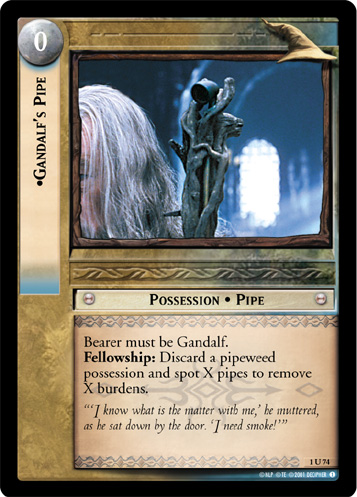 can remove quite a few burdens repeatedly, but only appears in Pipeweed decks, which are rare and not especially strong. After Shadows, in Expanded,
can remove quite a few burdens repeatedly, but only appears in Pipeweed decks, which are rare and not especially strong. After Shadows, in Expanded, Gandalf gets one of the strongest reusable burden removal tools in the game: Shadowfax, Greatest of the Mearas (17R24)
 (usually combined with Citadel to Gate (7R33)
(usually combined with Citadel to Gate (7R33)
 and/or Sting, Elven Long Knife (18R113)
and/or Sting, Elven Long Knife (18R113)
 to wipe the threats). Too Great and Terrible (3R85)
to wipe the threats). Too Great and Terrible (3R85)
 is one option to remove him, and possession hate like Úlairë Cantëa, Faster Than Winds (7R211)
is one option to remove him, and possession hate like Úlairë Cantëa, Faster Than Winds (7R211)
 or Grond, Hammer of the Underworld (8R103)
or Grond, Hammer of the Underworld (8R103)
 can deal with the horse. Those aren't the only problem cards: Watch and Wait (12R35)
can deal with the horse. Those aren't the only problem cards: Watch and Wait (12R35)
 is popular in any deck with strong skirmishers (notably Ents), and Járnsmid, Barding Emissary (12R30)
is popular in any deck with strong skirmishers (notably Ents), and Járnsmid, Barding Emissary (12R30)
 is strong, reusable burden removal as well. Just be ready to focus down problematic companions when facing a
is strong, reusable burden removal as well. Just be ready to focus down problematic companions when facing a Gandalf deck in Expanded.
Most other cultures only have one-shot cards to remove burdens, like Not Listening (6C43)
 or Elf-song (1C39)
or Elf-song (1C39)
 . Songs of the Blessed Realm (1C61)
. Songs of the Blessed Realm (1C61)
 is technically reusable, but few
is technically reusable, but few Elven decks run many copies of tales. Dwarven
 , Gondor
, Gondor
 , and Rohan
, and Rohan
 cultures have no burden-removal tools at all.
cultures have no burden-removal tools at all.
but many core cards, including One Good Turns Deserves Another
 , Déagol, Fateful Finder (13R46)
, Déagol, Fateful Finder (13R46)
 , and even Smeagol himself, add burdens
, and even Smeagol himself, add burdens
gondor dwarf rohan rely on a splash
scroll of isildur, gimli rb, galadriel rb

